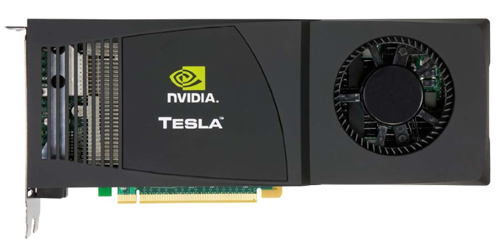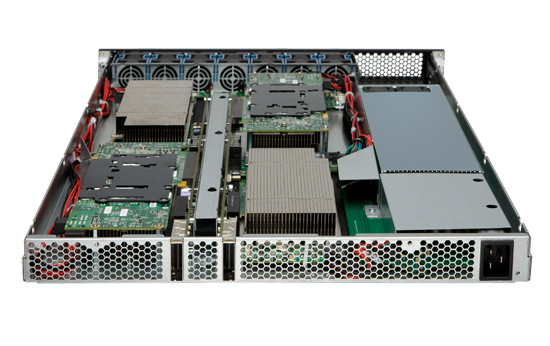NVIDIA's Fermi: Architected for Tesla, 3 Billion Transistors in 2010
by Anand Lal Shimpi on September 30, 2009 12:00 AM EST- Posted in
- GPUs
A Different Sort of Launch
Fermi will support DirectX 11 and NVIDIA believes it'll be faster than the Radeon HD 5870 in 3D games. With 3 billion transistors, it had better be. But that's the extent of what NVIDIA is willing to talk about with regards to Fermi as a gaming GPU. Sorry folks, today's launch is targeted entirely at Tesla.

A GeForce GTX 280 with 4GB of memory is the foundation for the Tesla C1060 cards
Tesla is NVIDIA's High Performance Computing (HPC) business. NVIDIA takes its consumer GPUs, equips them with a ton of memory, and sells them in personal or datacenter supercomputers called Tesla supercomputers or computing clusters. If you have an application that can run well on a GPU, the upside is tremendous.

Four of those C1060 cards in a 1U chassis make the Tesla S1070. PCIe connects the S1070 to the host server.
NVIDIA loves to cite examples of where algorithms ported to GPUs work so much better than CPUs. One such example is a seismic processing application that HESS found ran very well on NVIDIA GPUs. It migrated a cluster of 2000 servers to 32 Tesla S1070s, bringing total costs down from $8M to $400K, and total power from 1200kW down to 45kW.
| HESS Seismic Processing Example | Tesla | CPU |
| Performance | 1 | 1 |
| # of Machines | 32 Tesla S1070s | 2000 x86 servers |
| Total Cost | ~$400K | ~$8M |
| Total Power | 45kW | 1200kW |
Obviously this doesn't include the servers needed to drive the Teslas, but presumably that's not a significant cost. Either way the potential is there, it's just a matter of how many similar applications exist in the world.
According to NVIDIA, there are many more cases like this in the market. The table below shows what NVIDIA believes is the total available market in the next 18 months for these various HPC segments:
| Processor | Seismic | Supercomputing | Universities | Defence | Finance |
| GPU TAM | $300M | $200M | $150M | $250M | $230M |
These figures were calculated by looking at the algorithms used in each segment, the number of Hess-like Tesla installations that can be done, and the current budget for non-GPU based computing in those markets. If NVIDIA met its goals here, the Tesla business could be bigger than the GeForce one. There's just one problem:
As you'll soon see, many of the architectural features of Fermi are targeted specifically for Tesla markets. The same could be said about GT200, albeit to a lesser degree. Yet Tesla accounted for less than 1.3% of NVIDIA's total revenue last quarter.
Given these numbers it looks like NVIDIA is building GPUs for a world that doesn't exist. NVIDIA doesn't agree.
The Evolution of GPU Computing
When matched with the right algorithms and programming efforts, GPU computing can provide some real speedups. Much of Fermi's architecture is designed to improve performance in these HPC and other GPU compute applications.
Ever since G80, NVIDIA has been on this path to bring GPU computing to reality. I rarely get the opportunity to get a non-marketing answer out of NVIDIA, but in talking to Jonah Alben (VP of GPU Engineering) I had an unusually frank discussion.
From the outside, G80 looks to be a GPU architected for compute. Internally, NVIDIA viewed it as an opportunistic way to enable more general purpose computing on its GPUs. The transition to a unified shader architecture gave NVIDIA the chance to, relatively easily, turn G80 into more than just a GPU. NVIDIA viewed GPU computing as a future strength for the company, so G80 led a dual life. Awesome graphics chip by day, the foundation for CUDA by night.
Remember that G80 was hashed out back in 2002 - 2003. NVIDIA had some ideas of where it wanted to take GPU computing, but it wasn't until G80 hit that customers started providing feedback that ultimately shaped the way GT200 and Fermi turned out.
One key example was support for double precision floating point. The feature wasn't added until GT200 and even then, it was only added based on computing customer feedback from G80. Fermi kicks double precision performance up another notch as it now executes FP64 ops at half of its FP32 rate (more on this later).
While G80 and GT200 were still primarily graphics chips, NVIDIA views Fermi as a processor that makes compute just as serious as graphics. NVIDIA believes it's on a different course, at least for the short term, than AMD. And you'll see this in many of the architectural features of Fermi.










415 Comments
View All Comments
SiliconDoc - Thursday, October 1, 2009 - link
The R600 was great, you idiot.Of course, when hating nvidia is your real gig, I don't expect you to do anything but be parrot off someone else's text and get the idea wrong, get the repeating incorrect.
-
The R600 was and is great, and has held up a long time, like the G80. Of course if you actually had a clue, you'd know that, and be aware that you refuted your own attempt at a counterpoint, since the R600 was "great on paper" and also "in gaming machines".
It's a lot of fun when so many fools self-proof it trying to do anything other than scream lunatic.
Great job, you put down a really good ATI card, and slapped yourself and your point, doing it. It's pathetic, but I can;t claim it's not SOP, so you have plenty of company.
papapapapapapapababy - Wednesday, September 30, 2009 - link
because both ms and sony are copying nintendo...that means, next consoles > minuscule speed bump, low price and (lame) motion control attached. All this tech is useless with no real killer ap EXCLUSIVE FOR THE PC! But hey who cares, lets play PONG at 900 fps !
Lonyo - Wednesday, September 30, 2009 - link
Did you even read the article?The point of this tech is to move away from games, so the killer app for it won't be games, but HPC programs.
SiliconDoc - Thursday, October 1, 2009 - link
I think the point is - the last GT200 was ALSO TESLA -- and so of course...It's the SECOND TIME the red roosters can cluck and cluck and cluck "it won't be any good" , and "it's not for gaming".
LOL
Wrong before, wrong again, but never able to learn from their mistakes, the barnyard animals.
Zingam - Thursday, October 1, 2009 - link
Last time I bought the most expensive GPU available was Riva TNT!Sorry but even if they offer this for gamers I won't be able to buy it. It is high above my budget.
I'd buy based on quality/price/features! And not based on who has the better card on paper in year 20xx.
SiliconDoc - Thursday, October 1, 2009 - link
Well, for that, I am sorry in a sense, but on the other hand find it hard to believe, depending upon your location in the world.Better luck if you're stuck in a bad place, and good luck on keeping your internet connection in that case.
ClownPuncher - Thursday, October 1, 2009 - link
Or maybe he has other priorities besides being an asshole.SiliconDoc - Thursday, October 1, 2009 - link
Being unable, and choosing not to, are two different things.And generally speaking ati users are unable, and therefore cannot choose to, because they sit on that thing you talk about being.
Now that's how you knockout a clown.
Lord 666 - Wednesday, September 30, 2009 - link
That actually just made my day; seeing a VP of Marketing speak their mind.Cybersciver - Friday, October 2, 2009 - link
Yeah, that was cool.Don't know about you guys, but my interest in GPU's is gaming @ 1920X1200. From that pov it looks like Nvidia's about to crack a coconut with a ten-ton press.
My 280 runs just about everything flat-out (except Crysis naturally)and the 5850 beats it. So why spend more? Most everything's a consul port these days and they aren't slated for an upgrade till 2012, least last I heard.
Boo hoo.
Guess that's why multiple-screen gaming strating to be pushed.
No way Jose.